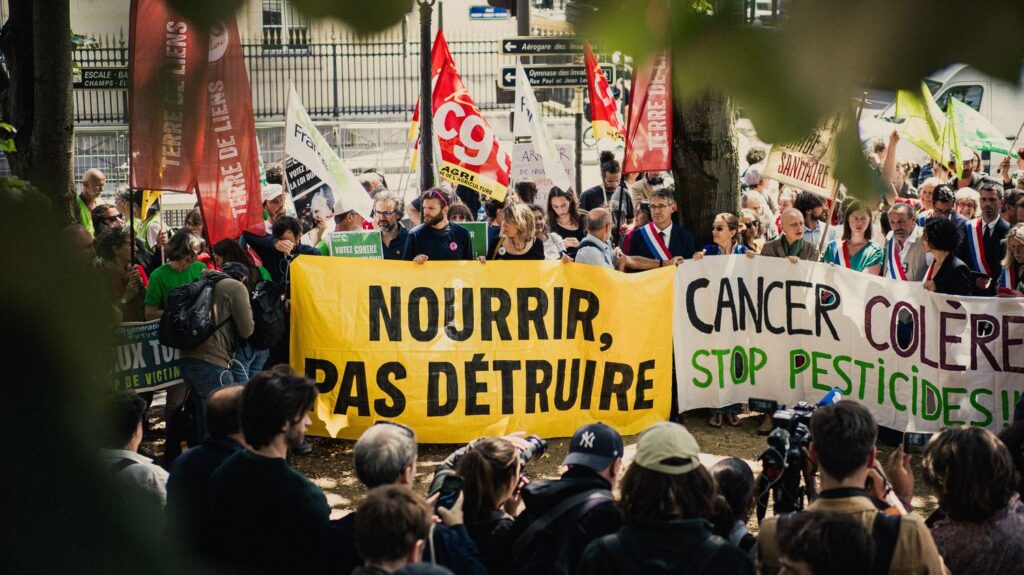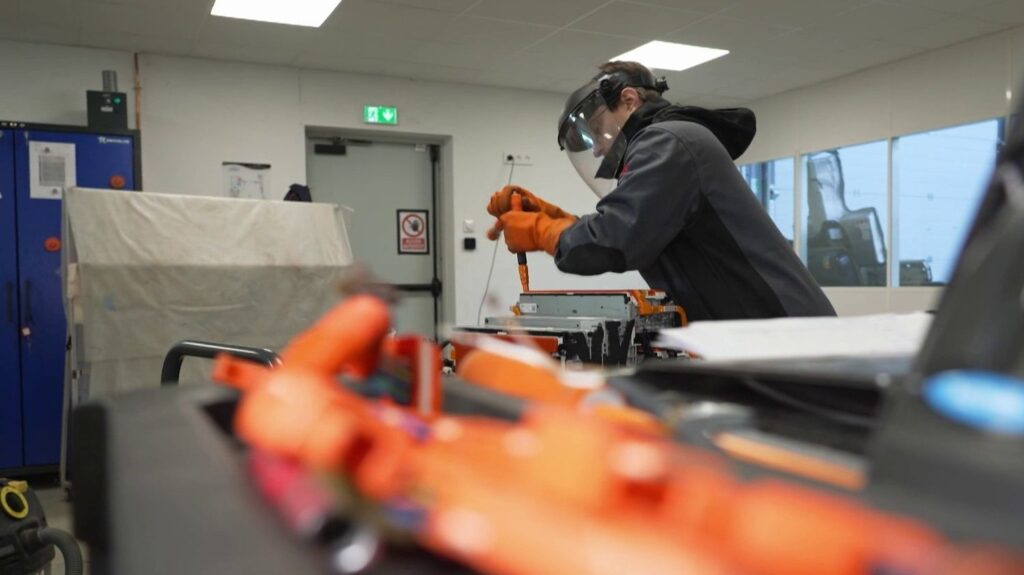/2025/07/23/080-hl-bohier-2825929-688097df9616c040647468.jpg)
If the defenders of the law greet a means of relaunching the French agricultural production apparatus, its opponents see it as a result of “an agro-industrial model”.
It aims to reintroduce acetamipride, a pesticide prohibited in France since 2018, facilitate the expansion or the creation of intensive farming buildings or even the storage of water for the irrigation of crops. Definitively adopted on July 8, the Duplo law, named after the Senator LR bearing the text, was intended to “lift the constraints in the exercise of the profession of farmer”. But in recent days it has triggered fiery debates. On the site of the National Assembly, a petition Criticizing its impact on the environment and health exceeded 1.7 million signatories on Wednesday, July 23.
On the one hand, its defenders greet the adoption of the law. The FNSEA, the first agricultural union, and its allies of young farmers evoke “A first step to restart our device (French) agricultural production “. On the other, many voices deplore a means of promoting “An agro-industrial model which in no way meets the expectations of the peasant world”According to the words of the peasant confederation, the third agricultural union in the country. In short, the illustration of a cleavage between two opposite visions of agriculture.
“The reality of what ecology is asking for is the end of French agricultureSoupped Sunday on franceinfo Laurent Duplomb. The less we produce in France, the more we will be subject to buying products which come from elsewhere and which do not correspond to our standards at all. ” The senator, former president of The Haute-Loire Chamber of Agriculture, is thus the mesh of the FNSEA, the text using “Several old claims of the agricultural majority union, historically opposed to the reduction in the use of pesticides”Site analysis The conversation Researcher Alexis Aulagnier. Without this law, “Less production, more dependence, a loss of competitiveness in the face of less-food agriculture”summarizes the pattern of the FNSEA, Arnaud Rousseau, on Liendin. Pour the unionthis law “Denounces a restrictive vision of ecology sacrificing farmers on the altar of ideology”.
What do we answer in front? Opponents of the law see it “The vision dated to a productivist agricultural model which sacrifices sustainability to immediate and without future performance”in the words of the network of Initiative centers to enhance agriculture and rural environment (CIVAM). Or “An agricultural model destructive of the environment and dangerous for health”Depending on the movement Land of links. “Our association asks the President of the Republic not to promulgate the DUPLomb law, which goes against the principles of precaution and promotion of a sustainable agricultural model”Embed the association Future generations.
To this model that they unanimously point to the finger, they oppose the many agroecological practices: organic agriculture, agroforestry, diversification of crops, grazing in orchards, biocontrol – which makes it possible to regulate diseases and pests using their natural predators -, implantation of hedges, mulching, cultures, pastoralism, annual rotation of cultures, according to a non -exhaustive list of The National Research Institute for Agriculture, Food and the Environment (INRAE).
“These types of agriculture have one thing in common: reduce unwanted consequences and work with nature rather than against it “Defines Vincent Bretagnolle, CNRS researcher at the Center for Biological Studies in Chizé. These systems also reduce “The consumption of energy, water, fertilizers, phytopharmaceutical products and veterinary drugs”In the words defined by The law of October 13, 2014. What improve the quality of the soils and water and capture carbon, while “Adjoining productivity”portrayed IPBES reportThe group of scientists specializing in biodiversity under the aegis of the UN.
Practices already experienced in France. “On July 1, 2024, 39,772 farms (were) High environmental value certified “,, according to the ministryand more than 60,000 operations were engaged in a biological production approach, according to The organic agency. “Yes, it is possible to reduce the intensive character and to do without glyphosate and without neonicotinoids. We experience it and it does not harm yields, or in a marginal manner”Assures Vincent Bretagnolle, who has been animating for thirty-two years an area for experimenting with new agroecological practices in the Center-West. “When we reduce the use of agrochemistry, it reduces the charges of farmers.” These alternatives emerged in the 1960s, traces INRAE. But they do not represent today “What 10%” About farmers, according to Vincent Bretagnolle.
Opposite, we therefore find the more intensive model, also called “productivist”, that is to say agriculture that seeks high yield, with, in particular, a significant recourse to chemical inputs. “The food industry must continue a double ambition, that of continuing to meet the food needs of the French and to help feed the world”also defines the FNSEA in Its productive pact for 2025. “This is the dominant model, around 90% of farmers in a major culture system”Notes Vincent Bretagnolle. And the trend goes in the direction of the expansion of farms: “In 2020, the surface of an exploitation in France was 69 hectares on average, against 55 in 2010”note INSEEwhich specifies that a quarter of the largest operations condense 68% of the French agricultural area.
This vision of agriculture involves many water and soil pollution with it as well as environmental damage. Agricultural activities are also one of the first causes of the collapse of biodiversity worldwide. “Mechanization has eliminated 70% of the linear hedges since 1950, which has prejudice to biodiversity. Since 1990, the surface of the meadows has decreased by 11%, and since 1989, 36% of the population of birds of agricultural environments has disappeared”illustrates INSEE.
But for researchers, current debates, focused on these two visions, are reductive. “The Dupumb law rather promotes a minority within these 90%Vincent Bretagnolle analysis. Those who are in very productivist models, turned almost 100% towards export, whose economic model is based on very large areas, very much mechanization and many inputs. ” A reading shared by Alexis Aulagnier, on The Conversation: “The DUPLOM law was supposed to be a legislative response to agricultural discomfort. It actually includes technical measures which only concern a reduced number of operators, in particular those who have operations with the most intensive orientation.”
Faced with this debate, a reality is essential, however: in a context of global warming and collapse of biodiversity, agriculture is forced to adapt and transform. First victims, farmers have indeed seen their yields decrease, their harvest advances, their land hits and new diseases weakening their farms. For Vincent Bretagnolle, “The productivist model is not viable in the long term”since“There is no production without ecosystems and biodiversity”. According to the researchers, transition is therefore the only solution. “Adaptation to climate change and the restoration of ecosystem services are essential to ensure productive and economic performance. The deployment of agroecology is considered the most relevant path in Europe to achieve this”judge Christian Huyghe, scientific director agriculture at INRAE.
When the IPCC warns in His latest report What “Certain areas currently devoted to agriculture and livestock will become climaticly unsuitable” – up to 10% worldwide by 2050, and more than 30% by 2100 in the worst scenarios of greenhouse gas emissions -, “It is impossible to predict how long this model will last, but you have to work on that of tomorrowexhort Vincent Bretagnolle. Now. “


